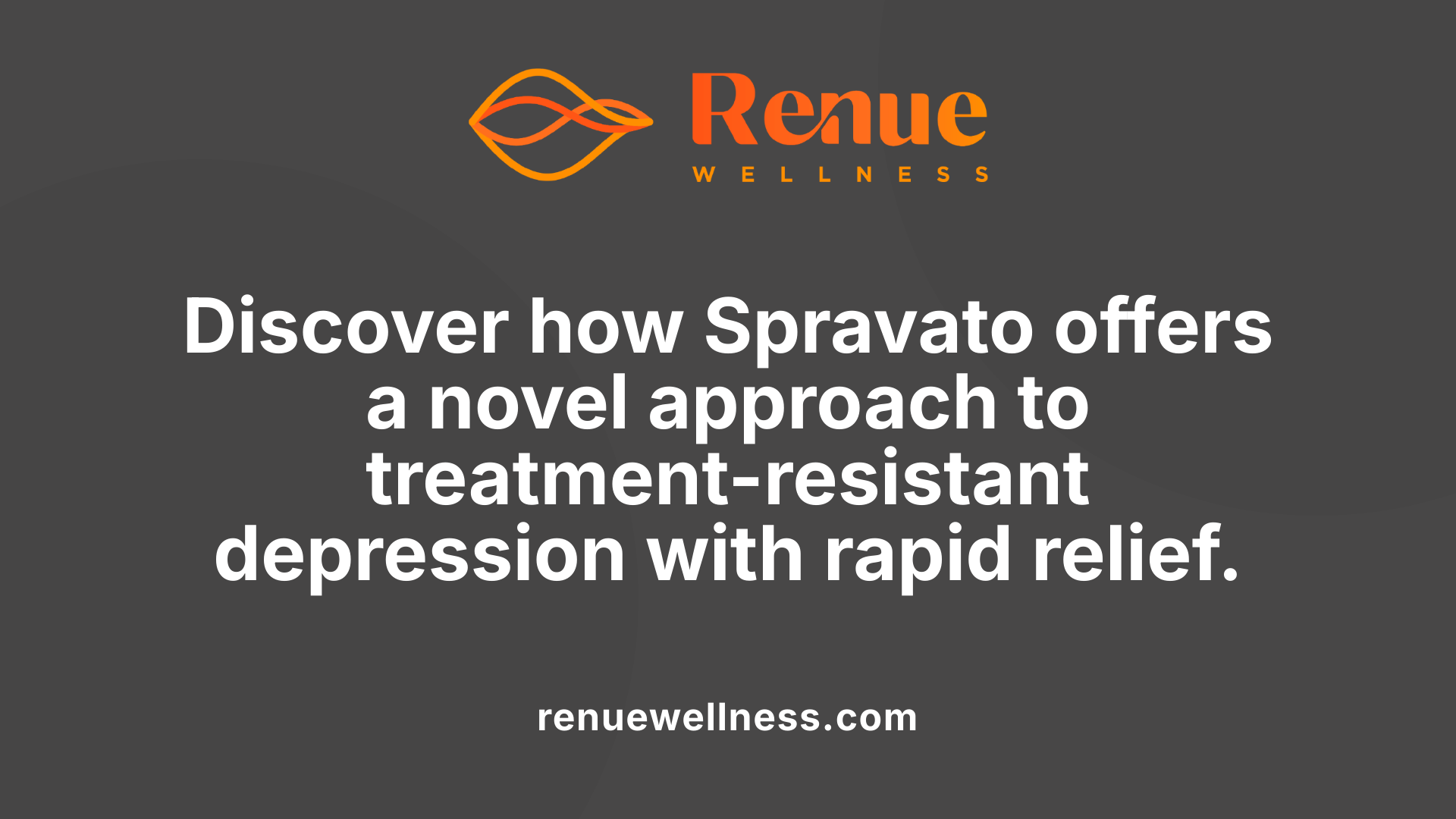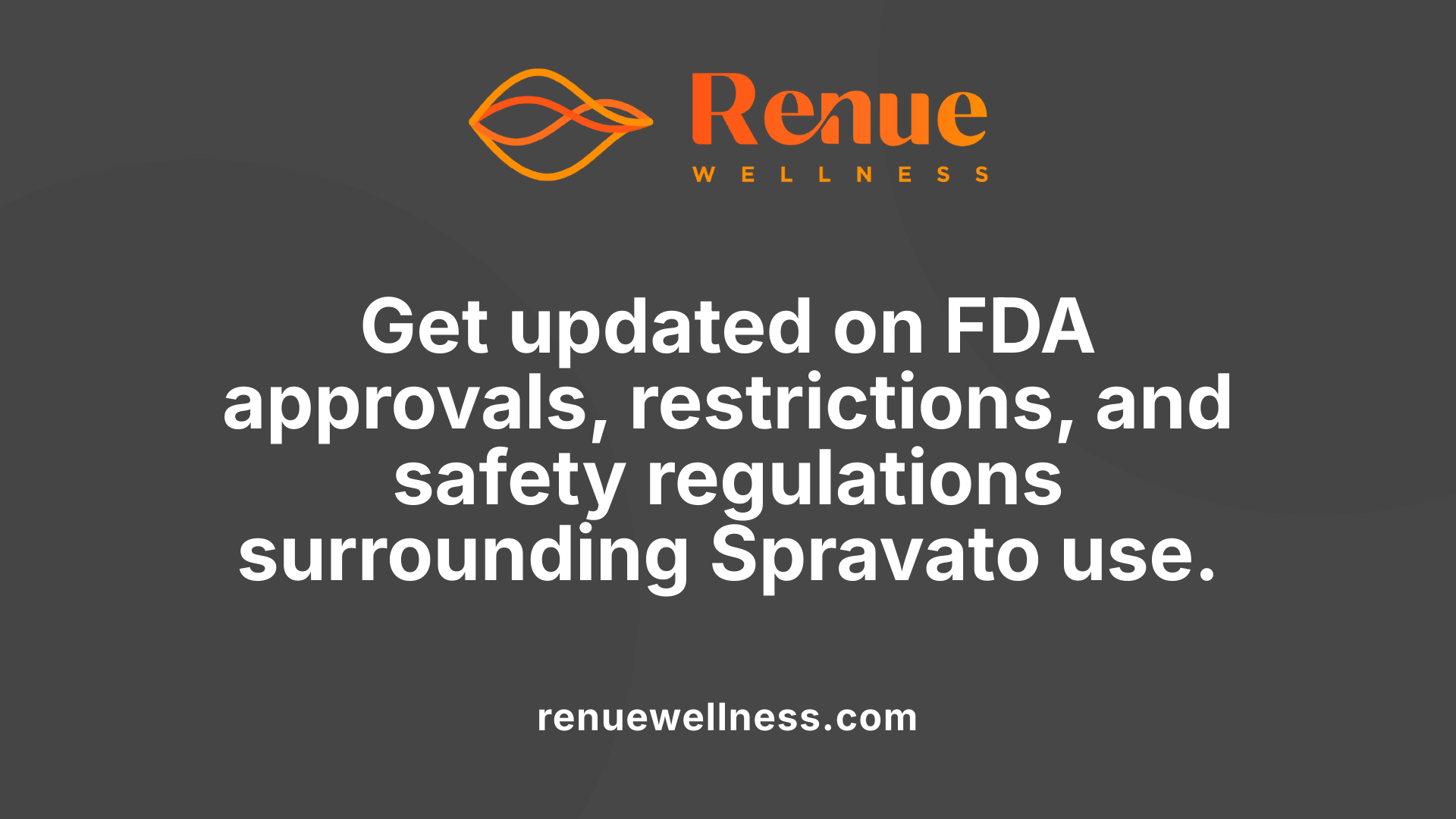What Is Spravato? A Comprehensive Guide to Intranasal Esketamine


July 30, 2025
Harnessing the Power of Intranasal Esketamine
Depression affects millions worldwide, and for many, traditional antidepressants are insufficient. Recent advancements have introduced a novel therapeutic option—Spravato, an intranasal esketamine formulation, providing hope for those with treatment-resistant depression (TRD). This comprehensive guide delves into the medication's mechanism, administration, efficacy, safety, and regulatory landscape, offering clinicians and patients an in-depth understanding of this groundbreaking treatment.
What is Spravato (esketamine) and what is its purpose?

What is Spravato (esketamine) and what is its purpose?
Spravato, which contains the active ingredient esketamine, is an intranasal spray approved by the U.S. Food and Drug Administration (FDA) for treating adults with treatment-resistant depression (TRD). This condition is characterized by a lack of response to at least two different antidepressant treatments, making it a significant challenge in mental health care.
Spravato is designed to be used as an adjunct therapy alongside traditional oral antidepressants. Its unique formulation allows for rapid administration and quick symptom relief, often within a few hours of treatment. It is administered under strict medical supervision because of its potential side effects, which include dissociation, sedation, increased blood pressure, and risks of misuse.
This medication is especially valuable for individuals with severe depression who have not responded to conventional treatments. In addition, it has an approved indication for adults experiencing depressive symptoms with suicidal thoughts or behaviors, providing critical support in emergency mental health situations.
Unlike standard antidepressants, which primarily target monoamine neurotransmitters such as serotonin and norepinephrine, Spravato works through a different mechanism involving the modulation of the brain's glutamate system. By antagonizing the NMDA (N-methyl-D-aspartate) glutamate receptor, esketamine increases neural connectivity and plasticity, promoting a rapid antidepressant effect.
The mechanism of action is thought to stimulate synaptic growth and enhance communication within neural circuits that are disrupted in depression. This innovative approach represents a shift in how depressive disorders can be treated, offering hope for those who do not find relief with traditional medications.
In summary, Spravato (esketamine) provides a novel, fast-acting option for adults with hard-to-treat depression, working through glutamate pathways to help restore normal brain function and alleviate symptoms efficiently.
How is Spravato administered and what are the procedures involved?

Administration route and device use
Spravato is administered as a nasal spray, which is designed to be used under medical supervision in a clinical setting. The medication comes in a specialized device that delivers a precise dose of esketamine directly into the nostrils. Patients typically receive doses while reclining at a 45-degree angle to optimize absorption and reduce the risk of side effects.
During treatment, healthcare providers demonstrate proper use of the nasal spray device, ensuring correct placement in each nostril. Patients are often trained to self-administer the spray after initial supervised doses, but always within the safety guidelines of the treatment center.
Monitoring requirements post-administration
Because of potential adverse effects such as dissociation, sedation, increased blood pressure, or respiratory issues, patients must be monitored closely after each dose. The standard protocol involves observing the patient for at least two hours following administration.
This observation period allows healthcare staff to detect and manage any side effects promptly. Patients should be advised not to drive, operate heavy machinery, or perform any risky activities during this time. It is recommended to have a responsible caregiver available to assist the patient after treatment and to ensure safe transportation home.
Dosage schedule and treatment duration
The initial prescribed regimen involves administering Spravato twice weekly for the first four weeks, known as the induction phase. Afterward, the frequency typically decreases to once weekly or every two weeks, depending on the patient's response and stability.
Treatment plans are individualized and can be adjusted based on ongoing assessment by the healthcare provider. The overall duration of therapy varies, and clinicians monitor for efficacy, side effects, and the possibility of tapering or discontinuing the medication.
Patient preparation and safety measures
Before administering Spravato, patients should undergo a thorough medical assessment, including blood pressure and psychiatric evaluations. They must abstain from alcohol, sedatives, or other substances that could increase the risk of adverse reactions.
Preparation also involves ensuring the patient is comfortable and relaxed, using mindful techniques to reduce anxiety. Casual clothing, hydration, and a calm environment can improve the experience.
Patients are informed about the possible side effects, such as dissociation and increased blood pressure, and are taught what symptoms require immediate medical attention. The treatment site is equipped with emergency measures, including medications and monitoring equipment, to address any acute issues.
Participation in the healthcare provider’s monitoring program and adherence to scheduled visits are crucial components of safety during Spravato therapy.
Mechanism of action: How does Spravato work in alleviating depression?

How does Spravato (esketamine) work as a treatment for depression?
Spravato, which contains esketamine, functions mainly as an NMDA receptor antagonist. NMDA receptors are a type of glutamate receptor involved in excitatory neurotransmission in the brain. By non-competitively blocking these receptors, esketamine alters glutamate activity, leading to increased glutamate release.
This surge in glutamate stimulates AMPA receptors, another subtype of glutamate receptor, which enhances neural signaling and plasticity. These effects activate intracellular pathways such as mTORC1, which promote the production of brain-derived neurotrophic factor (BDNF). BDNF is vital for neural growth and synaptic strength.
The cascade of these molecular events fosters synaptogenesis—the formation of new synapses—and structural neural changes that underpin mood regulation. Such neural remodeling is believed to be the foundation of the rapid antidepressant effects observed with esketamine.
By modulating glutamate neurotransmission and boosting neural plasticity, Spravato can produce significant improvements in depressive symptoms within hours or days, especially in individuals with treatment-resistant depression. The influence of esketamine on dopaminergic pathways may also alleviate feelings of anhedonia, although this can sometimes contribute to psychotomimetic effects such as dissociation.
In summary, Spravato’s mechanism involves a complex interplay of neurotransmitter modulation and neural proliferation, offering a faster route to symptom relief compared to traditional antidepressants that primarily target serotonin or norepinephrine pathways.
Safety profile, warnings, and side effects of Spravato

What are the side effects and safety considerations associated with Spravato?
Spravato (esketamine) is linked to a range of side effects that healthcare providers carefully monitor during treatment. Common adverse effects include dizziness, nausea, headache, sleepiness, vertigo, and disturbances in taste or touch sensation. Patients may also experience dissociation—such as feeling disconnected from oneself or the surroundings—which typically peaks around 30-40 minutes after administration and resolves within two hours.
Increased blood pressure is another frequent side effect, occurring in about 10% of patients, usually resolving within a couple of hours. Some individuals report a sensation of feeling intoxicated or euphoric, akin to being drunk. Other minor side effects include vomiting, nasal discomfort, and transient feelings of euphoria or sedation.
Serious risks associated with Spravato necessitate strict medical supervision. These include respiratory depression, bladder issues, severe allergic reactions, or cognitive impairment. Additionally, there is an increased concern for suicidal thoughts or behaviors, especially in young people, which is why the drug carries boxed warnings. Due to these potential adverse events, Spravato is only administered in certified healthcare settings, with patients monitored for at least two hours post-dose.
What are the serious risks and contraindications?
Beyond typical side effects, Spravato has several absolute contraindications. It should not be used in patients with hypersensitivity to esketamine or those with certain medical conditions such as aneurysmal vascular disease, severe hypertension, or recent cardiovascular events like stroke or heart attack. Patients with a history of substance abuse require cautious evaluation because of the drug’s potential for misuse and abuse.
The medication is also contraindicated in pregnancy and breastfeeding, given potential risks to the fetus or infant. Patients with severe liver or pulmonary conditions should avoid Spravato unless closely supervised.
How are monitoring protocols and precautions implemented?
Due to the risks involved, treatment with Spravato involves comprehensive protocols. Patients are enrolled in the REMS (Risk Evaluation and Mitigation Strategy) program, which mandates healthcare providers to ensure proper education, informed consent, and adherence to safety measures.
Treatment sessions require monitoring for at least two hours to observe for adverse effects such as blood pressure spikes, dissociation, or sedation. Blood pressure should be checked before administration and periodically afterward. Patients are advised to avoid driving or operating machinery following doses.
Ongoing assessment of mental health, using tools like PHQ-9, M-ACE, and suicide risk evaluations, helps in managing treatment effectiveness and safety.
Are there special populations or precautions to consider?
Certain populations require extra caution. Individuals with significant hepatic impairment, uncontrolled hypertension, or a history of psychosis should be evaluated thoroughly before initiating therapy. Pregnant women or those breastfeeding should avoid the medication unless absolutely necessary.
Vulnerable groups, such as young adults at risk of suicidal behavior, need careful monitoring due to the potential for increased suicidal thoughts with the medication.
In sum, while Spravato offers rapid relief for treatment-resistant depression, its administration and follow-up require a structured, cautious approach to minimize risks and optimize safety.
Regulatory status and approval landscape for Spravato

Is Spravato approved by the FDA and what are its regulatory considerations?
Yes, the FDA has approved Spravato (esketamine) nasal spray for treating adults with treatment-resistant depression (TRD) and for depressive symptoms in adults experiencing major depressive disorder (MDD) with acute suicidal ideation or behavior. The initial approval came in March 2019, marking it as the first nasal spray derived from ketamine with approval for psychiatric use.
Since its initial clearance, the FDA has expanded its indications. In July 2020, it approved Spravato for use specifically in cases of MDD with current suicidal thoughts or actions, highlighting its role in rapid symptom relief.
Regulatory considerations include its status as a Schedule 2 controlled substance, reflecting the risk of misuse and dependency. Because of this, Spravato is only available through a special program called the REMS (Risk Evaluation and Mitigation Strategy). This program enforces strict rules for prescribing, dispensing, and administration.
Healthcare providers must enroll in the REMS program, and the medication can only be administered in certified clinics under direct supervision. Patients undergo monitoring for at least two hours post-dose to observe for adverse effects such as dissociation, sedation, or increased blood pressure.
Overall, Spravato's approval status involves careful regulatory oversight to maximize its benefits while minimizing potential risks. Its fast-track designation reflects the urgent need for effective treatments in severe depression cases, ensuring access while enforcing safety measures.
Regulatory Highlights:
- Approved in 2019 for TRD in adults
- Expanded in 2020 for depressive symptoms with suicidal ideation
- Strict REMS program to prevent misuse
- Available only under medical supervision
- Schedule 2 controlled substance
This regulatory environment underscores the importance of cautious and monitored use of this innovative therapy in mental health treatment.
Efficacy and clinical evidence supporting Spravato
How effective is Spravato as a treatment option for depression?
Spravato (esketamine nasal spray) has shown strong evidence of effectiveness in treating adults with treatment-resistant depression (TRD). Results from numerous clinical trials have demonstrated that Spravato, when used alongside traditional oral antidepressants, can produce rapid symptom relief. In studies, many patients experienced noticeable improvements within just 24 hours, with benefits extending up to 28 days.
The primary measure of its effectiveness is a significant reduction in MADRS scores, a standard scale for assessing depression severity. These trials reveal that a higher proportion of patients treated with Spravato reached response and remission compared to placebo groups. For example, at week 4, about 22.5% of patients taking Spravato achieved remission, compared to only 7.6% on placebo.
Long-term data highlight that continued use of Spravato helps maintain its antidepressant effects and may even decrease the likelihood of relapse. Patients who respond initially can often sustain improvements with ongoing treatment, though long-term safety and efficacy are still under investigation.
While effective, Spravato's benefits are accompanied by manageable side effects such as dissociation, dizziness, and increased blood pressure, usually resolving within a couple of hours. Its rapid action makes it especially useful for patients with acute suicidal ideation or severe depression unresponsive to other medications.
Overall, Spravato offers a promising option for adults with depression not helped by standard treatments, but it necessitates supervised administration and close monitoring because of potential adverse effects.
Comparison with other depression treatments
How does Spravato compare to other depression treatments?
Spravato (esketamine) stands out as a unique and effective option for tackling treatment-resistant depression (TRD). Unlike traditional antidepressants, which often take weeks to show effects, Spravato offers rapid symptom relief, with some patients experiencing improvement within 24 hours. It is administered as a nasal spray in clinical settings, supervised by healthcare professionals, and is specifically approved for adults who have not responded to at least two other antidepressant treatments.
One of the main competitors to Spravato is IV ketamine infusion. Both involve targeting the glutamate system to produce antidepressant effects. IV ketamine is typically given through intravenous infusion in specialized clinics, often at a higher cost and without the same FDA approval for specific depression indications. While both treatments have demonstrated similar benefits in short-term symptom reduction, ketamine infusions are usually used off-label and require multiple sessions over several weeks.
Spravato's convenience as a nasal spray, combined with its insurance coverage under FDA approval, makes it a preferred choice for many patients. It is also associated with a monitored treatment process to mitigate risks like dissociation and blood pressure spikes. Meanwhile, ketamine infusions, though effective, involve more intensive setup and monitoring, and often lack FDA official endorsement for depression.
In the treatment hierarchy, Spravato is positioned as a valuable option after traditional antidepressants and other modalities like TMS or psychotherapy have failed. Its rapid onset and ability to reduce suicidal thoughts quickly make it particularly useful in acute settings.
| Treatment Method | Administration Route | Typical Setting | Main Advantages | Limitations | Cost & Insurance |
|---|---|---|---|---|---|
| Spravato | Nasal spray | Healthcare clinic | Rapid relief, FDA-approved, accessible | Short-term safety data, requires monitoring | Widely covered with insurance |
| IV ketamine | Intravenous infusion | Specialized clinics | Similar efficacy, rapid action | Off-label, higher cost, less convenient | Limited insurance coverage |
| Traditional Antidepressants | Oral | Home | Long-term use, safe | Slow onset, less effective in TRD | Usually covered |
Overall, Spravato's profile of rapid efficacy, approved safety, and user-friendly administration makes it a standout among depression treatments, especially for those with limited options due to resistance or acuity.
A Promising Step Forward in Depression Management
Spravato (esketamine) represents a significant advancement in the treatment of resistant depression, offering rapid symptom relief and a novel mechanism of action. Its approval and structured administration in supervised medical settings help ensure safety while providing hope to patients unresponsive to traditional therapies. Ongoing research and clinical experience continue to refine its optimal use, positioning Spravato as a vital option within the broader landscape of depression management.
References
- Intranasal Esketamine (SpravatoTM) for Use in Treatment-Resistant ...
- SPRAVATO® (esketamine) approved in the U.S. as the first and only ...
- Preparing for IV Ketamine or Spravato Treatment: A Comprehensive ...
- Pros and Cons of SPRAVATO Therapy for Depression Treatment
- [PDF] Intranasal Esketamine for Treatment Resistant Depression - VA.gov
- Spravato | European Medicines Agency (EMA)
- Benefits and risks of esketamine nasal spray continuation in ...
- Proven Effective for Treatment Resistant Depression - Spravato
- Spravato (Esketamine) Dosage: Forms, Frequency, Adjustments
Recent Posts
Conditions Treated
AnxietyDepressionOCDPTSDPostpartum DepressionPain ManagementSubstance AbuseSuicidal IdeationOur Location


